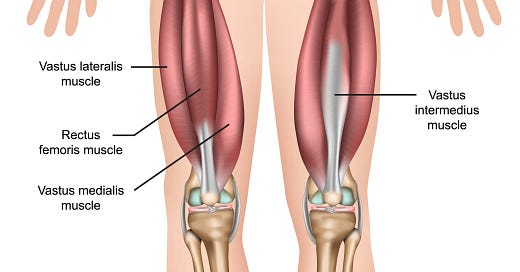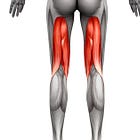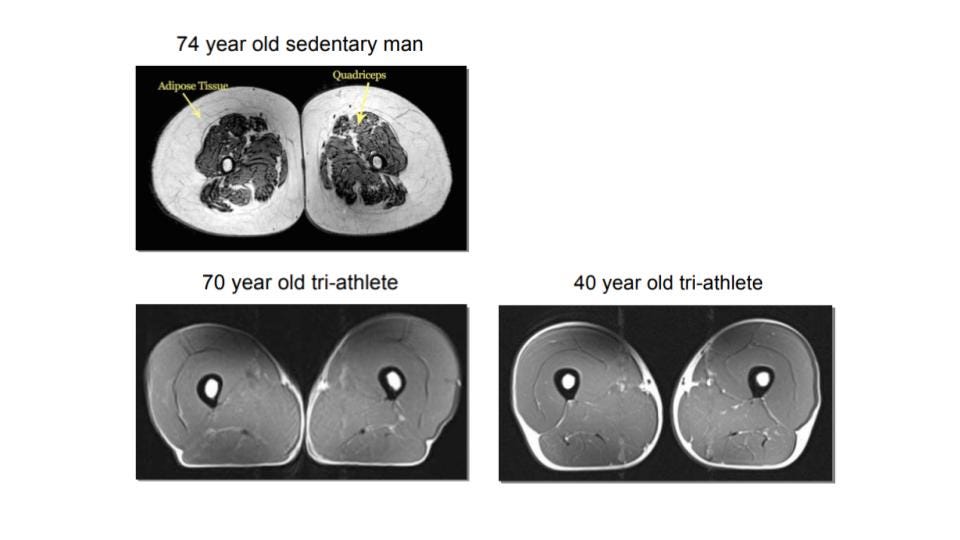This week’s edition of Muscle Monday will be the last of 2024. Today, we look at the quadriceps, which sit on the opposite side of the thigh to the hamstrings. If you haven’t had a chance to read through last week’s outline on those three muscles, take a look below.
Muscles of the quadriceps
The quadriceps femoris, quadriceps, or quads for short (quadriceps meaning four heads, and femoris relating to the femur, or thigh) unsurprisingly refers to a group of four muscles at the front of the thigh. These are outlined below.
The rectus femoris is the muscle at the centre of the thigh. If you look at the image above, you’ll be able to see that it actually crosses both the hip and knee joints, since it originates at the ilium, which is the upper part of the hip bone.
The vastus lateralis, as the name suggests, is the most lateral (toward the outside of the thigh/away from the midline) of the four muscles.
The vastus medialis is therefore the most medial (toward the inside of the thigh/toward the midline) of the four muscles. It can be further divided into the vastus medialis longus (VML), and vastus medialis oblique (VMO). The VMO is the bottom segment of the muscle, often described as ‘teardrop-shaped’ and can be particularly prominent in fit individuals.
The vastus intermedius is located underneath the rectus femoris, in the centre of the thigh.
Function of the quadriceps muscles
The quadriceps as a whole are responsible for knee extension (straightening the knee) and hip flexion (decreasing the angle at the hip, for example, by lifting the knee upwards). However, certain muscles have specific roles.
The rectus femoris
Since it is the only one of the four muscles to cross both the hip and knee joints, it is also the only muscle to perform both of the primary actions of the quadriceps muscles: extending the knee and flexing the hip.
The vastus lateralis, intermedius and medialis
The three other muscles primarily serve two functions: knee extension, and stabilisation of the patella (kneecap).
Unique conditions (Besides strains and tears)
Due to their proximity to, and role in stabilising the kneecap, the quadriceps can play a part in any injury which affects the patella. A common example of this might be patellar tendinitis which is otherwise known as jumper’s knee. It is frequently recognised by a sharp pain at the front of the kneecap, and rehabilitation exercises can focus on the strengthening of the quadriceps muscles.
The quadriceps muscles are quite unique in that they are responsible for deceleration and braking. If you’ve ever been in a hike up a hill, but found that your quads and knees suffer either coming either downhill, or in the days after, then this is why. Every step downhill requires an eccentric contraction of the quads, which means that they lengthen under tension. This type of contraction is most often associated with increased muscle soreness after exercise.
As a group, the quadriceps are the most voluminous muscles in the body. It is therefore more obvious when we lose muscle mass (sarcopenia) from our quads than other muscles in the body. I always bring up the picture below, which highlights the difference in quadriceps muscle mass for an active older individual compared to a sedentary older individual. The sarcopenia is represented by the lack of grey in the top picture, relative to the bottom two.
Strengthening the quadriceps muscles
To strengthen the quads, we first need to remember their primary actions: knee extension and hip flexion. Therefore, any exercise which replicates these movements will prove valuable:
Any squat variant (although a narrow stance and/or front load can increase the emphasis on the squats).
A machine leg press exercise
Lunges or split squats
Machine leg extensions
If looking to increase the intensity, some plyometrics exercises, such as box jumps or squat jumps will also help to develop strength in the quads. Using bands can also decrease the difficulty of exercise if needed, compared to free weights.
Thanks for this week’s quick read. Have a lovely holiday period and we will return in 2024! If you’re still reading, and have an Instagram account, please follow me as I try to up my game next year….






